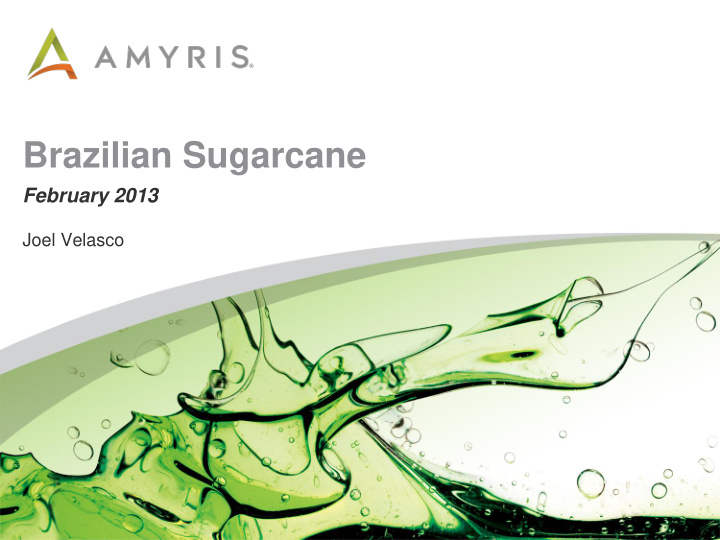



Brazilian Sugarcane February 2013 Joel Velasco
Safe Harbor Summary This presentation and oral statements accompanying this presentation contain forward-looking statements, and any statements other than statements of historical facts could be deemed to be forward-looking statements. These forward-looking statements include, among other things, statements regarding future events (such as Amyris’s financial outlook, anticipated products, production roadmap and construction of production facilities, short-term and long-term product sales expectations, commercialization expectations, production volumes and costs for various potential products and associated product launch expectations, and expectations for R&D and commercial relationships) that involve risks and uncertainties. These statements are based on management’s estimates and current expectations and actual results and future events may differ materially due to changes in Amyris’s business and various risks and uncertainties, including those associated with any delays or failures in development, production and commercialization of products, liquidity and ability to fund capital expenditures, Amyris’s reliance on third parties to achieve its goals, and other risks detailed in the “Risk Factors” section of Amyris’s quarterly report on Form 10-Q filed on November 9, 2012. Amyris disclaims any obligation to update information contained in these forward-looking statements whether as a result of new information, future events, or otherwise.
High-Value Products from Sugarcane INDUSTRIAL SYNTHETIC BIOLOGY PLATFORM CHEMICALS & PLANT SUGARS FUELS
Brazil is #1 in Sugarcane Brazil is the world’s largest cane producer , twice #2 India Brazil's South-Central region accounts for 90% of country’s cane harvest Brazil’s sugarcane sugar yields have grown at 3% CAGR since late 1970s Source: University of Minnesota Institute on the Environment; Brazilian Sugarcane Industry Association (UNICA), Food and Agricultural Organization (FAO)
Sugarcane Industry in Context Sugarcane occupies 2.5% of Brazil’s arable land to produce over 600 million tons per crop year Millions of Hectares (2012) Brazil Land 850 Arable Land 330 Crop Land 70 Soybean 27 Corn 15 Sugarcane 8.5 Cattle Pasture 198 1 Hectare = 2.5 acres Source: UNICA, CONAB, IBGE 5
Land Uses in Brazil Total Area Native Vegetation Land in Use Other Uses 554 258 38 850 100% 65% 30% 5% Million Hectares Conservation Protected Other Native Units and ILs Areas Vegetation 135 204 215 Pasture 24% 16% 25% 198 Crop Land 23% Sugarcane 60 8.5 7% ~1% Source: ICONE, IBGE (PAM 2010 and Censo Agropecuário), MMA, INPE (TerraClass), Agricultural Land Use and Expansion Model Brazil Ag-LUE-BR (Gerd Sparovek, ESALQ/USP). Developed by: UNICA and Cosan. Note: ILs = Indigenous Lands. Other Native Vegetation include Legal Reserves (RLs)
Brazilian Industry Output SUGARCANE +500 Million Tons ⅖ of World Crop RAW SUGAR 37 Million Tons ¼ of World Demand ETHANOL 6 Billion Gallons ½ of U.S. Production ELECTRICITY 1,500 MW ~3% of Brazil Demand Source: UNICA, CONAB. Data is estimate for 2011 crop year. Source: UNICA and MAPA. Note: Data is estimate.
Source: UNICA and MAPA. Note: 12/13 data is estimate. Sugar (million tons) Ethanol (billion liters) Historical Production 10 15 20 25 30 35 40 45 0 5 75/76 76/77 77/78 78/79 79/80 80/81 81/82 82/83 Sugarcane 83/84 84/85 85/86 86/87 87/88 88/89 89/90 90/91 91/92 92/93 Sugar 93/94 94/95 95/96 96/97 97/98 98/99 99/00 00/01 Ethanol 01/02 02/03 03/04 04/05 05/06 06/07 07/08 08/09 09/10 10/11 11/12 12/13* 0 100 200 300 400 500 600 700 Sugarcane (million tons)
Agricultural Challenge CROP SIZE PRODUCTIVITY Metric Tons Tons per Hectare 700 95 600 90 500 85 400 80 300 75 200 70 100 0 65 03/04 04/05 05/06 06/07 07/08 08/09 09/10 10/11 11/12 12/13 03/04 04/05 05/06 06/07 07/08 08/09 09/10 10/11 11/12 12/13 Source: CENSO – CTC. 12/13*- data until January 2013.
Market Challenge R$/Liter 1.80 Gasoline Price at the Pump (including only federal taxes) 1.60 1.40 1.20 1.00 + 34% 0.80 While pump prices remained stable, the net price 0.60 paid to refineries increased by 34% through 0.40 reduced taxation in the period 0.20 0.00 2002 2003 2004 2005 2006 2007 2008 2009 2010 2011 2012 Feb-13 Source: ANP. Compiled by: UNICA.
UNICA Vision: Growth Needed 2020 SCENARIO 1,400 1,2 Billion tons SUGAR: To meet domestic Sugarcane Production in (MT) 1,200 demand and retain current share (50%) of global sugar market, annual sugar production will have 1,000 886 to increase by 13.7 million tons Million tons by 2020. 800 560 ETHANOL: Projected production to meet 50% (vs 36% currently) Million tons 600 of estimated ethanol market in Brazil plus about export demand 400 of about 13 billion liters (4 BGY). OTHERS: Other uses of 200 sugarcane could account for upwards of 5 billion liters ethanol- 0 equivalent. 2011/12 2015/16 2020/21 Sugar Anhydrous Ethanol Hydrous Ethanol Source: UNICA. Note: Estimated values of the harvest 2011/12.
Recommend
More recommend